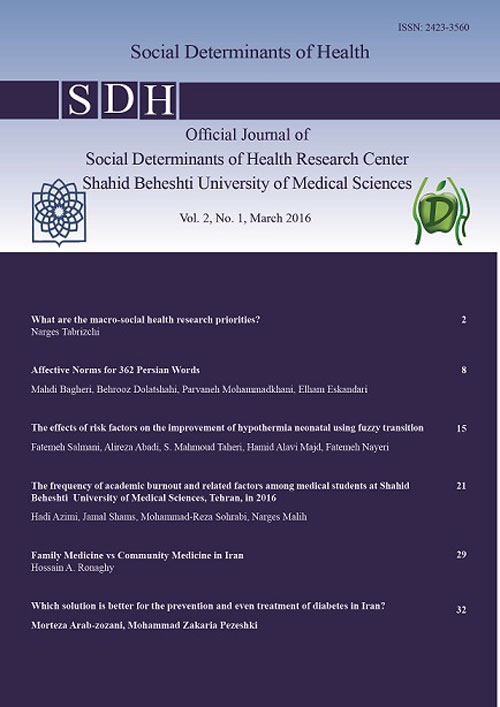فهرست مطالب

Social Determinants of Health
Volume:2 Issue: 3, 2016
- تاریخ انتشار: 1395/09/30
- تعداد عناوین: 4
-
-
Pages 84-91Subject: The aim of this research is to study the effects of low dose aspirin on preventing any adverse pregnancy outcome in women with aneuploidy abnormal screening tests in second quarter and to compare the effects of aspirin on normal and abnormal Doppler.MethodThis clinical trial study was performed on pregnant women with abnormal aneuploidy screening tests and normal Karyotype at the gestational age 15-18 week. It consists of 83 persons in aspirin receiving group and 84 persons in control group. Doppler ultrasound was simultaneously done on them to survey the Doppler results. Any adverse pregnancy outcome (APO) was compared between two groups.ResultsThe frequency of APO was 32.8% in aspirin receiving group and 41.7% in control group (p=o.o14, RR=0.438). The frequency of preterm delivery before 37th week in the group receiving aspirin with normal Doppler was 8.07% and in the control group was 32.7% (P=0.025). The frequency of NICU reception with normal Doppler was 5.8% in aspirin group and 19.7% in control group (p=0.015). APO frequency in the group with many abnormal factors was 11.5% in the group receiving aspirin and 53.8% in control group (p=0.015). APO frequency in abnormal Doppler group was 46.7% in the group receiving aspirin and 50% in control group (p=0.849, RR=0.112).ConclusionLow dose of aspirin reduces APO. It reduces preterm delivery and reference of pregnant women to NICU with abnormal aneuploidy screening tests.Keywords: Adverse Pregnancy Outcome, Aneuploidy, Doppler, Screening
-
Pages 92-97BackgroundThe concept of the quality of life (HRQOL) related to health and its determinants contain aspects of quality of life that clearly affect peoples physical or mental health. One of the newest ways to assess the health and also the quality of life-related to health is the self-assessed health of the individual. The aim of the present study was assessment of unhealthy days, self-reported health status, and its influencing factors on residents of the marginalpart of Mashhad, Iran.MethodsIn the current cross-sectional study, 580 citizens of the marginal regions and slum areas of Mashhad city were enrolled through cluster sampling method using governmental health care services divisions. The Persian version of the questionnaire CDC HRQOL-4 was used to measure the unhealthy days. Data was analyzed using SPSS, version 11.5, running ANOVA, chi-square, and t-tests. P-value of less than 0.05 was considered as statistically significant.ResultsIn the present study, 359 persons (61%) were women and the mean age of participants was 32.6±11.51 years. The means of unhealthy days, physically unhealthy days, mentally unhealthy days, and days with dysfunction were found to be 7.2, 2.8, 4.1, and 1.7 days, respectively. The unhealthiest days (physical and mental) were seen in unemployed people and the best to excellent health days were seen in housewives.ConclusionUnhealthy days and days with dysfunction were reported higher in slum inhabitants, especially female, low literacy, and housewife participants. Providing the education and employment facilities for people who live in marginal city areas might decrease the unhealthy days.Keywords: Unhealthy days, Health, Urban Marginal Inhabitants, Mashhad
-
Pages 98-105BackgroundEating attitude disorders may indicate an increased risk for eating disorders and their chronic health complications. The purpose of the present study was to determine the prevalence of eating attitude disorders and to identify the factors associated with them among female students in Tehran.
MethodsA total of 1418-year-old high school girls (N=619) completed a standardized self-report Eating Attitude Test (EAT-26) questionnaire and a demographic questionnaire. Mental health problems were investigated by means of the Patient Health Questionnaire-2 and the Generalized Anxiety Disorders-2.
ResultsBased on EAT-26 scores, 153 (24.7%) students had eating attitude disorders. There was no relationship between abnormal eating attitudes and both individual and socioeconomic factors (P>0.05). Logistic regression analysis demonstrated that eating attitude disorders were significantly associated with depression [OR=1.8 (1.2-2.8), P=0.007], anxiety [OR=1.6 (1.1-2.4), P=0.04], and perception of body shape as overweight [OR=2.7 (1.7-4.3), PConclusionA relatively high rate of eating attitude disorders was found among adolescent school girls in Tehran. Related factors were body image and psychological issues including depression and anxiety. Preventive and screening programs in schools could identify students at risk and prevent development and complications of eating disorders.Keywords: Eating disorder, Eating attitude, EAT-26, Adolescents, Cross-Sectional Study, Tehran -
Pages 106-114BackgroundPhenomenon of addiction as one of the social problems has a high prevalence, especially among youth. The aim of the present study was to compare personality traits based on the temperament and character inventory in opiate and stimulant addicts in Tehran.
MethodsIn the present quasi-experimental study, 60 male addicts (30 opiate and 30 stimulant addicts) who referred to addiction treatment centers in the suburbs of Tehran were selected through convenience sampling method and were studied using Temperament and Character Inventory (TCI). The participants were sorted according to their age and education.
ResultsThere was a significant difference between the two groups with regard to harm avoidance, reward dependence, cooperativeness, and self-transcendence traits. Thus, opiate addicts had higher levels of harm avoidance, reward dependence, and cooperativeness, and stimulant addicts had higher levels of self-transcendence. The significance level was set at PConclusionThe obtained results showed that there was a significant difference between opiate and stimulant addicts. Opiate addicts gained higher scores, compared with stimulant addicts, in Temperament and Character Inventory variables. The obtained results also showed that stimulant addicts were suffering from more severe disorders than opiate addicts. Based on the means of the values of the TCI, personality traits reflecting personality disorders are detectable and predictable in substance abusers. This new understanding is important in the prevention and treatment of addiction.Keywords: Addict, Character, Opiate, Personality, Stimulant, Temperament

